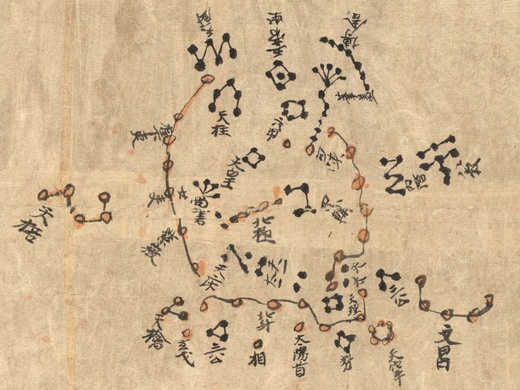 
 字體:小 中 大
字體:小 中 大 |
|
|
|
| 2010/05/31 18:09:45瀏覽833|回應2|推薦1 | |
敦煌星象圖部份:Credit and Copyright: J.-M. Bonnet-Bidaud (CEA, Saclay), F. Praderie (Obs. Paris) … … 2009年,全球壟罩在金融風暴陰霾底下,地面黯淡,天空卻是星光燦爛。 為了紀念1609年伽利略首次用望遠鏡進行天文觀測400週年,由國際天文 聯合會(The International Astronomical Union, IAU)與聯合國教科文組織(UNESCO) 推動的「2009全球天文年」(International Year of Astronomy 2009.IYA2009), 主題是「我的宇宙,我來探索!」(The Universe, Yours to Discover.),全球 共有超過150個國家與國際組織熱烈響應。這位當年被宗教裁判所判為異 端,人生最後十年在軟禁下度過的「現代科學之父」,史蒂芬·霍金說: 「自然科學的誕生要歸功於伽利略,他這方面的功勞大概無人能及。」 2009全球天文年主題曲:Shoulders of Giants,歌詞裡「that on the Shoulders of Giants....... we'll see beyond!... we'll stand on the Shoulders of Giants (Galileo knew)」 唱出對伽利略的讚美,台灣主辦單位的訴求是『希望人類能在夜空中 「重新發現」我們在宇宙中所處的地位,更進一步地能夠對發現的欣 喜和探索知識的喜悅有親身的體驗』。 … 倫敦英國圖書館為慶祝全球天文年,展出1907年所發現的敦煌星象圖 (Dunhuang Star Atlas),這幅圖繪製於唐朝、距今約1350年前,是現今保 存最古老的星象圖。圖中中心點北極星,是孔子說的北辰─『為政以 德,譬如北辰,居其所而眾星共之。』《論語.為政第二》… 人類由少數家族、部落、族群、城邦的演化,群聚效應產生了「視人 如親」的現象,這項被稱為演化的美麗錯誤,最新的研究報告 (sciencemag.org on March 18, 2010)指出,為了公平分配、互惠互利,人 類從二十萬年前石器時代小團體間經常性的衝突,急轉彎變成對陌生 人抱持善意。火種改變遠古生活形態,善意使人類走出穴居發展文明。 持續這種善意,孔子說的「德」,其實沒有艱澀的奧義,領導者各以 善意來管理國家機器,就像星球與星球之間的相互輝映。…… 在奧萬大、阿里山或東部光害較少的地方,夜裡仰望天空,群星相互 輝映,每一顆幾乎都是獨一無二、會微笑的星球,小朋友們會猜想那 顆是B612星球。大人的徐志摩偷偷在日記裡說:「數大就是美」。… 相互輝映的星球,多麼美麗啊。親愛的孔夫子也不禁讚嘆:「里仁為 美」《論語.里仁第四》。里字《春秋·穀梁傳》「古者,三百步一里」, 《傳》「里,居也」,《周禮·地官·遂人》「五家爲鄰,五鄰爲里」, 《漢書·食貨誌上》「六尺為步」,按商鞅量尺、新莽銅斛尺、後漢建 武銅尺一尺等於0. X415. 孫丑章句上》又有「湯以七十里,文王以百里」的論述,複數的里連 結成國。 … 周朝初時有1800國,到春秋早期,剩下100多國,而後歷經弱小被併吞、 君主被殺、保平安的會盟失效,100多國拼湊成戰國七雄和10幾個小國, 再經秦帝國的降臨,所有的星星完全消失,只剩下一個烈日當空。司馬 遷悲嘆:「嗚呼!君臣之禮既壞矣,則天下以智力相雄長,遂使聖賢之 後為諸侯者,社稷無不泯絕,生民之害糜滅幾盡,豈不哀哉!」《資治 通鑒·卷第一》…… 雖然孔子「不語怪力亂神」《論語•述而第七》,我們由衷佩服他的先知與 遠見。從『子曰:「我未見好仁者,惡不仁者。好仁者,無以尚之;惡 不仁者,其為仁矣,不使不仁者加乎其身。有能一日用其力於仁矣乎? 我未見力不足者。蓋有之矣,我未之見也。」』及『能以禮讓為國乎』 到『德不孤,必有鄰』《論語.里仁第四》,最後這六字,似乎已預見「失 德無鄰」的終結。 |
|
| ( 時事評論|政治 ) |










